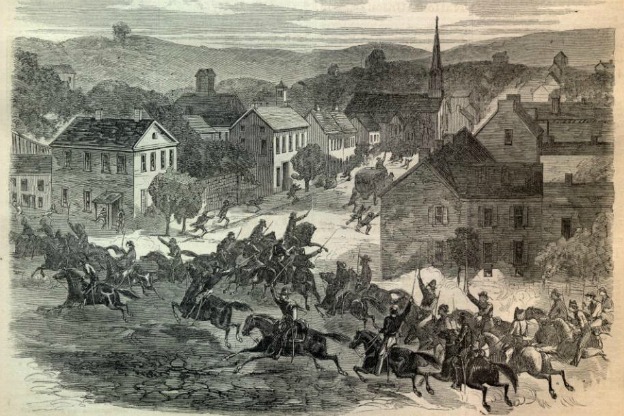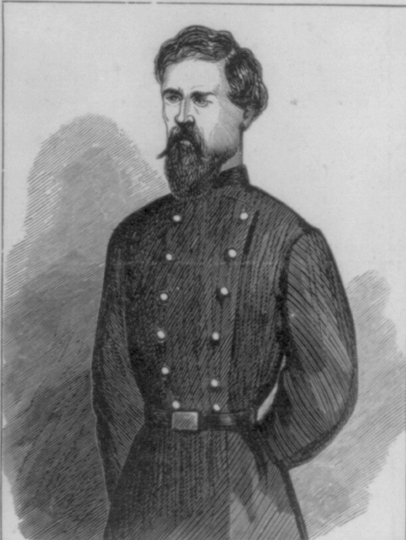http://www.memoriallibrary.com/IL/South/History/twenty-six/index.htm
***
"...KNIGHTS OF THE GOLDEN CIRCLE
The Ohio river from a few miles below Pittsburg to Cairo was the dividing line between freedom on the north and west and slavery on the south and east. West Virginia (then a part of "Old Virginia") and Kentucky were slave states and Ohio, Indiana, and Illinois were free states. All three of these free states had been settled in an early day largely from slave states. Southern Illinois was almost wholly settled, up to the Civil war, from the older slave states. And while some of these people moved out of the slave states to get away from slavery very many sympathized with the southern people. It was not to be expected therefore to find the south half of Ohio, Indiana, and Illinois enthusiastic for the prosecution of the war. It was easy for the secessionists to come out of the states of Tennessee, Kentucky, and Virginia and find in Southern Illinois enthusiastic sympathizers.

The first two years of the war were not successfully prosecuted. P 318
Beyond the capture of Forts Henry and Donelson, and the victory of Pittsburg Landing, the government had no substantial fruit as the result of the war. This accounts for Illinois going Democratic in the fall of 1862. The issuing of the Emancipation Proclamation alienated from the support of the government many good citizens and influential leaders. Now while these good citizens could not openly oppose the prosecution of the war, they desired in some way to exert an influence looking toward the cessation of hostilities and the restoration of "peace at any price." To meet the need of organized effort there was brought forward semi-military secret societies that assumed a number of names. The first organization was known as the Circle of Honor. Later the name changed to Knights of the Golden Circle, and still later to the Order of American Knights, and finally to the Order of Sons of Liberty.
It was the Knights of the Golden Circle mainly which was organized in Southern Illinois, and later the order was known as the Sons of Liberty. Quite a little of the information furnished the government relative to this organization was obtained by Felix G. Stidger, a United States government secret service agent, who was in 1864 grand secretary of the order of Sons of Liberty in the state of Kentucky. Mr. Stidger made a full report to the secret service department of the government and it is incorporated in the report of Judge Advocate General J. Holt, to the department of war on October 8, 1864. In addition to this government report Mr. Stidger, in 1903, after the passions of the war had subsided, wrote a full and complete history of his connection with the order. The organization was as follows: (1) A supreme council, whose officers were supreme commander, secretary of state, and a treasurer. (2) A grand council, whose officers were a grand commander, deputy grand commander, grand secretary, and grand treasurer. (3) County parent temples: the officers were commander, secretary, and treasurer. There was a military, department in connection with the organization. The supreme commander was commander in chief; grand commanders were commanders of the forces of their respective states. There were four major generals for a state, and each congressional district was under a brigadier general. The county was under a colonel, and the forces of a township were under a captain. The writer remembers very distinctly as a school boy, being in the home of a schoolmate when an older brother of the schoolmate arrived from Alton with a one-horse buggy full of revolvers. They were encased in black leather with belt attached. It was a great privilege of the two boys to take the revolvers from the buggy and assist in carrying them into the house. He remembers also that one of the "Knights" was later captured by soldiers and lodged in a prison at Springfield along with five other brothers. Here the "Knight" died and the body was returned to the home for burial. We all went to the funeral and as we trudged along the side of the procession, the "Knights" to the number of thirty or more rode with military order behind the hearse, their revolvers in their black leather cases buckled to their waists.
It is now half a century since those troublous times, and it is with difficulty that one can get first hand information concerning the organization known as the Knights of the Golden Circle. Personal correspondence with responsible people in the several counties has revealed the fact that the order was in a flourishing condition in most of the counties in southern Illinois. We append a few of these replies, omitting names. P 319
Saline county: "The order existed here during the Civil war. Members were not numerous, and while threats of violence were made against strong union men, they lacked the leadership and courage to put their threats into execution. These Knights went to the home of a Mr. Jobe, a discharged soldier, to order him to leave the country. He was sick in bed, but calling for his gun he told them to come into his house at their peril. At this day most of the members of this order are either dead or ashamed they ever belonged to it. In either ease one can not get personal information. Judge Duff, who was arrested in Marion in the fall of 1862, was held as a prisoner in Washington for three months. In March, 1863, while holding court in Harrisburg he delivered a great tirade on "Arbitrary Arrest by the Federal Government." That was "Black Monday" for loyal union men of Saline county. The Union League was organized in Saline county in several places, and its influence had a salutary effect upon Copperheadism."
Cumberland county: "The Knights of the Golden Circle was organized in this county, but it is difficult to get reliable information."
Richland county: "Those who sympathized with the south were mustering in different sections of the county, and even made an attempt to raid the provost-marshal's office in Olney, to get the draft papers. Colonel O`Kane, who was provost-marshal, wired Governor Dick Yates, and a company of soldiers were sent to protect the office and restore order generally."
Crawford county: "While teaching at `Big Brick' (District No. 58), some years ago, I was told that the forty acres on which the school house is located, a beautiful level piece of land, was used as a drill ground by the Knights of the Golden Circle during the war. There were those who watched them from a distance on moonlight nights."
Monroe county: "Yes, there were Knights of the Golden Circle in this county, but I know nothing about them except they were rebels at heart and secret enemies of the flag.
Pope county: "I did not know of any in this county. I knew of Golden Circles in Kentucky. Its purpose was to oppose the Union.
Members of this order abused union men who would not join them. Families of unionists who went to war were ill treated by this order."
Wabash county: "Yes, the Knights of the Golden Circle was organized in this county. There was lots of them. The purpose of them was to preserve the peace in their vicinity, and protect their homes, let the invasion come from any source or place. They did not want to go to the war unless drafted, and then they had secret signs that might save them from death, if they were taken prisoners in the war. It was not of much use here, as we had no trouble in our county. I probably know something about it, for I organized about two hundred of them in our county (he probably means 200 members), and Lawrence county. We never did any harm to anybody, and when the war was over, the organization died a natural death."
Perry county: "Yes, the Golden Circle was organized in Perry county. Some of the members lived in Tamaroa."
Richland county: "No. Richland county was loyal to the union. However, lust across in Edwards to the south, and in Jasper at the north, they had this order. Its object was to discourage enlistments, aid and abetting the south. The Union League was for exactly the opposite purpose. There was never a draft on Richland. She was P 320 always ahead on her quota. Company E, Eleventh Missouri Volunteer Infantry was the result of the worked-off surplus from this county. Just across in Edwards county the enlistments were few, as they were descendants of southern families, and were in sympathy with their cause. A draft was run on this precinct (in Edwards county) and as the office of Provost-Marshal O`Kane was in Olney and as he held the list of names drawn, it was the plan of the Knights to move upon Olney, seize the list, and burn it, destroying Olney if necessary to· accomplish their plans. The Jasper Knights were to march from the north and assist. Perhaps, sometime late in the fall of `64, they astonished the citizens of the county by riding in squads bearing arms, and near 0lney they had assembled. The Union Leaguers occupied the town and the unarmed citizens were supplied from the hardware stores as the report had gone out that the city was to be burned. When all was in readiness, the sheriff went out to the Knights and commanded them to disband and to return to their respective homes or he would be compelled to scatter them by force of arms. Sentinels and pickets were stationed and no one could enter Olney that night without the password. The Knights began to disperse and long before morning were gone. This is the nearest we came of having trouble during the existence of the Knights of the Golden Circle."
Effingham county: "There were no Knights of the Golden Circle in this county, but in our neighboring county of Marion a certain prominent judge was said to be high priest in that order."..."
***
~Jay~
http://knightsofthegoldencircle.webs.com





